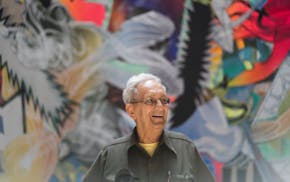Deep in the Demilitarized Zone (DMZ), an area about 160 miles long and 2½ miles wide that separates North and South Korea, former South Korean soldier Mr. Kim sets out on his covert sunset-to-sunrise shift.
As he meanders through the dangerous yet fascinating area — an ecological wildlife haven but filled with some 1 million antipersonnel mines — artist Hayoun Kwon overlays Kim's audio onto a video of his memory in the DMZ made in virtual reality.
Kwon's video "489 Years," named for how long it would take to clear all the landmines in the DMZ, is part of the exhibition "The Shape of Time: Korean Art After 1989″ at the Minneapolis Institute of Art. The exhibition comes to Minneapolis from the Philadelphia Museum of Art and includes the works of 25 artists of Korean descent. Two works in the show come from Mia's collection.
"It's an exhibition that is deeply rooted in the history of Korea, both North and South, but really it's something that addresses themes of gentrification, globalization, loss, mourning, so there are themes that resonate across different populations," said Associate Curator of Global Contemporary Art Leslie Ureña. "It's really been a great experience to get to know these artworks, and more about the history of South Korea, but also how these themes are ones that we can resonate beyond South Korea."
Chronologically, the show begins around the 1988 Summer Olympics in Seoul, South Korea, and meanders through various themes and events, such as the mourning associated with people who disappeared during the Gwangju Uprising in 1980, Shamanism, gentrification, gender and identity.
For Noh Suntag's ongoing series "Forgetting Machines," he visited the tombs of people killed or disappeared during the Gwangju Uprising (May 18-27, 1980), a protest that took place after the coup d'état of May 17, installing a military dictator. The deteriorating portraits of the deceased, including their cause of death, paint a ghostly memory that continues to haunt contemporary Korean culture.
Kyungah Ham's mysterious works "What you see is the unseen/Chandeliers for Five Cities SK 01-06″ and "What you see is the unseen/Chandeliers for Five Cities BR 04-04″ were made in collaboration with anonymous North Korean artists. Her project began when she discovered North Korean propaganda in front of her house. For more than 10 years, she has worked with intermediaries from China or Russia who have been able to pass her designs — chandeliers that suggest various stages of instability — to artists in North Korea, who work in their tradition of hand embroidery. Communication with North Koreans is forbidden.
In Juree Kim's "Evanescent Landscape — Hwigyeong: Philadelphia, 2023; Minneapolis, 2024," the artist creates a miniature urban landscape in the neighborhood where her studio used to be. All of the structures are in the midst of falling apart, with shattered facades, buildings tipping to one side and debris everywhere. Using unfired clay, the landscape itself could dissolve in water.
"As the process of gentrification unfolded, the country was modernizing," Ureña said. "These houses were torn down and new ones and high-rises and whatnot were built."
Such scenes of gentrification may be familiar to those who have seen Bong Joon-ho's "Parasite," a dark comedy/thriller about social class divides in Korean culture, screening at Mia on May 5 as part of the exhibition.
Artist Kelvin Kyung Kun Park's three-channel film "A Dream of Iron" juxtaposes imagery from Pohang's iron industry, Hyundai shipyards in Ulsan, protest imagery, whales (familiar from prehistoric petroglyphs in Korea) and ritualistic music. The past and present blend together, united through Shamanistic means. (Shamans communicate between the living and the dead.)
"At the time of making the piece, I imagined the death of an industrial era in South Korea, like Belfast or Detroit," Park said. "The work was my attempt at processing the conflicting dichotomy between authoritarian industrial powers versus democratic powers within the South Korean political context, which I felt is still haunting us today.
"I wanted to proclaim death, or create a proper funeral ritual to the past," Park said. "I thought the role of an artist is to look at life from the position of death, to destroy archaic meanings to create new ones."
Park's video screened at the Museum of Modern Art in New York 10 years ago, and he feels like there's less difference in cultural context nowadays.
"I am very happy to be showing works in America, of course, because I got more immediate and honest reactions from the American audience," he said. "I love it!"
**
'The Shape of Time: Korean Art After 1989′
When: Exhibition ends June 23.
Film screening: "Parasite" on May 5 at 2 p.m.
Where: Minneapolis Institute of Art, Target Galleries, 2400 3rd Av. S.
Hours: 10 a.m.-5 p.m. Tue., Wed., Fri.-Sun, 10 a.m.-9 p.m. Thu.
Cost: $16-$20, free for ages 17 and under.
Info: new.artsmia.org or 612-870-3000

Helen Simonson is in Jane Austen mode with 'The Hazelbourne Ladies Motorcycle and Flying Club'

Frank Stella, towering artist and master of reinvention, dies at 87
Angel Reese, Cardoso debuts watched widely on fan's livestream after WNBA is unable to broadcast

